| Srl | Item |
| 1 |
ID:
137832
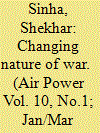

|
|
|
| 2 |
ID:
085786


|
|
|
|
|
| Publication |
2008.
|
| Summary/Abstract |
In January of 2007, China knocked one of its weather satellites out of orbit, and threw the international community into panic. Some figured the satellite-killer test was the harbinger of a future war in space that could cripple a technology-dependent United States military. This viewpoint examines the possibilities of a Chinese assault on American satellites.
|
|
|
|
|
|
|
|
|
|
|
|
|
|
|
|
| 3 |
ID:
132719
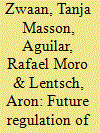

|
|
|
|
|
| Publication |
2014.
|
| Summary/Abstract |
The EU 7th Framework Project FAST20XX [1] aimed to enlarge the foundations of suborbital high-speed transportation in a wide variety of fields. One of the key issues of this project was to outline a desirable regulatory framework that would best serve the interests of all European stakeholders in this new activity.
The US Federal Aviation Administration (FAA) has issued a series of requirements for operators of commercial suborbital flights under the 2004 Commercial Space Launch Amendments Act (CSLAA), enabling the corresponding market to develop. These regulations were initially valid until 2012 but have now been extended until 2015.
In Europe, practical and successful attempts to fly experimental vehicles of this kind do not yet exist. However, several developments indicate that it is becoming urgent to pay attention to this potential new industry and find ways to regulate it in a safe yet flexible manner. Although the European Aviation Safety Agency (EASA) explored the possibility in 2008 to prepare for a certification approach under the concept of "Suborbital Aeroplanes" (SoA), this initiative was put on hold in 2011, and a final decision by the European Commission is still pending.
This paper highlights some of the research performed by the authors towards the establishment of a roadmap for future regulation of suborbital flight in Europe. In particular, it will present results of a survey carried out among stakeholders, including operators and manufacturers of vehicles, spaceports, national and European regulators, insurers and brokers, consultants, users and lobbyists. The paper also presents results from the workshop on the future regulatory framework for suborbital flights in Europe, which was co-organised by the present authors and held in Brussels in October 2012.
|
|
|
|
|
|
|
|
|
|
|
|
|
|
|
|
| 4 |
ID:
153022


|
|
|
|
|
| Publication |
Oxford, Oxford University Press, 2017.
|
| Description |
x, 219p.hbk
|
| Standard Number |
9780198788171
|
|
|
|
|
|
|
|
|
|
|
|
Copies: C:1/I:0,R:0,Q:0
Circulation
| Accession# | Call# | Current Location | Status | Policy | Location |
| 059103 | 355.02/CRE 059103 | Main | On Shelf | General | |
|
|
|
|
| 5 |
ID:
125373
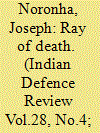

|
|
|
|
|
| Publication |
2013.
|
| Summary/Abstract |
Why do laser guns and other DEW devices seem so much more attractive than conventional projectile weapons such as guns and missiles? For one thing, DEWs can be precisely targeted. It is claimed of some airborne laser weapon systems, that while engaging a moving truck, the attacker may choose whether to simply burn the tyres and immobilise the vehicle, hit the engine and disable it or set the fuel tank alight and trigger an inferno. Similarly, while targeting a person, energy output can be controlled at will, high power to kill or low power to deliver an intensely unpleasant experience and serve as a stern warning: "Get lost, or else…!"
|
|
|
|
|
|
|
|
|
|
|
|
|
|
|
|
| 6 |
ID:
186555
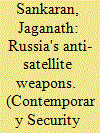

|
|
|
|
|
| Summary/Abstract |
Russia has recently tested several anti-satellite weapons. The Russian military literature reveals hedging and offsetting strategies behind these actions. First, Russians cast their weapons as a mirror response to American experiments. Russians fear a technological surprise and suggest that their experimentation hedges against significant advantages that may accrue to the United States from dominating space. Second, Russians perceive satellites providing vital targeting and navigation information as crucial enablers of U.S. and NATO aerospace precision strike weapons. Therefore, dependence on space-based assets is a vulnerability that Russia cannot fail to take advantage of in a crisis to offset U.S. and NATO military superiority. Some unilateral measures such as deploying cheaper and distributed small satellite constellations can reduce U.S. and allied vulnerabilities. Bilateral behavioral norms can offer reassurances to both the United States and Russia. However, deeper regulation and limits on emerging strategic aerospace weaponry may also be required.
|
|
|
|
|
|
|
|
|
|
|
|
|
|
|
|
| 7 |
ID:
104109


|
|
|
|
|
| Publication |
2011.
|
| Summary/Abstract |
The US - China military space relationship has been driven by the security dilemma in international relations. China pursues military space capabilities in part to counter in perceived national security threats posed by the US quest for space dominance and missile defence. However, the current strategic adjustment by the Obama administration and the altered situation at the Taiwan Strait have moderated the bilateral security dilemma, offering on opportunity for arms control in outer space
|
|
|
|
|
|
|
|
|
|
|
|
|
|
|
|
| 8 |
ID:
161004
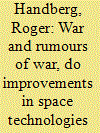

|
|
|
|
|
| Summary/Abstract |
Combat in near-Earth orbit is emerging as a more realistic possibility. The argument here is that changes in space technologies combined with a sea change in political rhetoric is bringing the possibility of military conflict in space technologies. This movement reflects a generational shift as the original decisions regarding military conflict in space are now being reassessed by a generation who did not experience World War II or the Cold War. For these, the sanctuary approach to space activities is not as persuasive and new enhanced space technologies bring the possibility of victory or at least survival possible during a conflict in space.
|
|
|
|
|
|
|
|
|
|
|
|
|
|
|
|